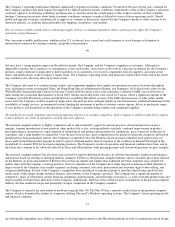Apple 2003 Annual Report Download - page 34
Download and view the complete annual report
Please find page 34 of the 2003 Apple annual report below. You can navigate through the pages in the report by either clicking on the pages listed below, or by using the keyword search tool below to find specific information within the annual report.
The Company's operating performance depends significantly on general economic conditions. For much of the past several years, demand for
the Company's products has been negatively impacted by difficult global economic conditions. Additionally, some of the Company's education
customers appear to be delaying technology purchases due to concerns about the overall impact of the weaker economy on their available
funding. Continued uncertainty about future economic conditions continues to make it difficult to forecast future operating results. Should
global and regional economic conditions fail to improve or continue to deteriorate, demand for the Company's products could continue to be
adversely affected, as could the financial health of its suppliers, distributors, and resellers.
War, terrorism or public health issues could disrupt supply, delivery or demand of products which could negatively affect the Company's
operations and performance.
War, terrorism or public health issues, whether in the U.S. or abroad, have caused and could continue to cause damage or disruption to
international commerce by creating economic and political uncertainties
40
that may have a strong negative impact on the global economy, the Company, and the Company's suppliers or customers. Although it is
impossible to predict the occurrences or consequences of any such events, such events could result in a decrease in demand for the Company's
products, make it difficult or impossible to deliver products to its customers, or to receive components from its suppliers, and could create
delays and inefficiencies in the Company's supply chain. The Company's operating results and financial condition have been, and in the future
may continue to be, adversely affected by these events.
The Company and some of its manufacturing vendors and component suppliers have significant operations in various locations throughout
Asia, including locations in mainland China, the Hong Kong Special Administrative Region, and Singapore, all of which were subject to the
World Health Organization and Centers for Disease Control and Prevention severe acute respiratory syndrome (SARS) travel advisories at
times during the second and third quarters of fiscal 2003. Similar travel advisories were issued for Taiwan, where a significant amount of the
Company's portable Macintosh systems and the iPod are assembled. Should the severity of the SARs threat increase or other public health
issues arise, the Company could be negatively impacted by the need for more stringent employee travel restrictions, additional limitations in the
availability of freight services, governmental actions limiting the movement of products between various regions, delays in production ramps
of new products, and disruptions in the operations of the Company's manufacturing vendors and component suppliers.
The market for personal computers and related peripherals and services is highly competitive. If the Company is unable to effectively compete
in these markets, its results of operations could be adversely affected.
The personal computer industry is highly competitive and is characterized by aggressive pricing practices, downward pressure on gross
margins, frequent introduction of new products, short product life cycles, evolving industry standards, continual improvement in product
price/performance characteristics, rapid adoption of technological and product advancements by competitors, price sensitivity on the part of
consumers, and a large number of competitors. Over the past several years, price competition in the market for personal computers and related
peripherals has been particularly intense. The Company's competitors who sell Windows-based personal computers have aggressively cut
prices and lowered their product margins in order to gain or maintain market share in response to the weakness in demand that began in the
second half of calendar 2000 for personal computing products. The Company's results of operations and financial condition have been, and in
the future may continue to be, adversely affected by these and other industry-
wide pricing pressures and downward pressures on gross margins.
The personal computer industry has also been characterized by rapid technological advances in software functionality, hardware performance,
and features based on existing or emerging industry standards. Further, as the personal computer industry and its customers place more reliance
on the Internet, an increasing number of Internet devices that are smaller and simpler than traditional personal computers may compete for
market share with the Company's existing products. Several competitors of the Company have either targeted or announced their intention to
target certain of the Company's key market segments, including consumer, education, professional and consumer digital video editing, and
design and publishing. Several of the Company's competitors have introduced or announced plans to introduce digital music products that
mimic many of the unique design, technical features, and solutions of the Company's products. The Company has a significant number of
competitors, many of whom have greater financial, marketing, manufacturing, and technological resources, as well as broader product lines and
larger installed customer bases than those of the Company. Additionally, there has been a trend towards consolidation in the personal computer
industry that has resulted in larger and potentially stronger competitors in the Company's markets.
The Company is currently the only maker of hardware using the Mac OS. The Mac OS has a minority market share in the personal computer
market, which is dominated by makers of computers utilizing Microsoft's Windows operating systems. The Company's future operating results
and financial condition
41
are substantially dependent on its ability to continue to develop improvements to the Macintosh platform in order to maintain perceived design
























